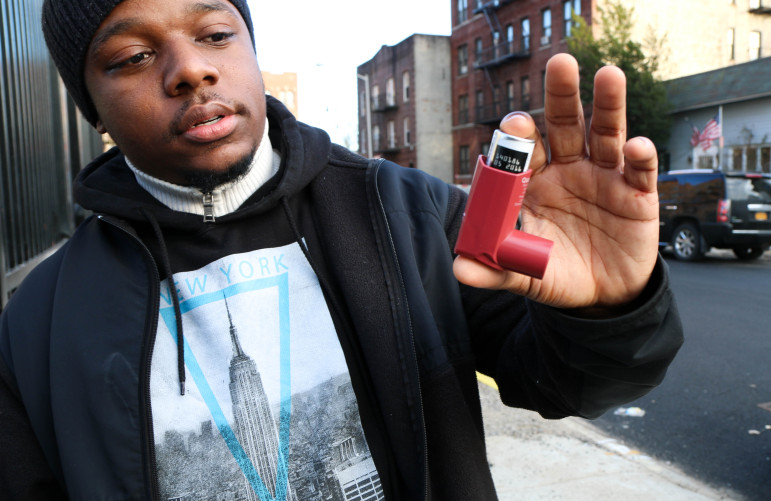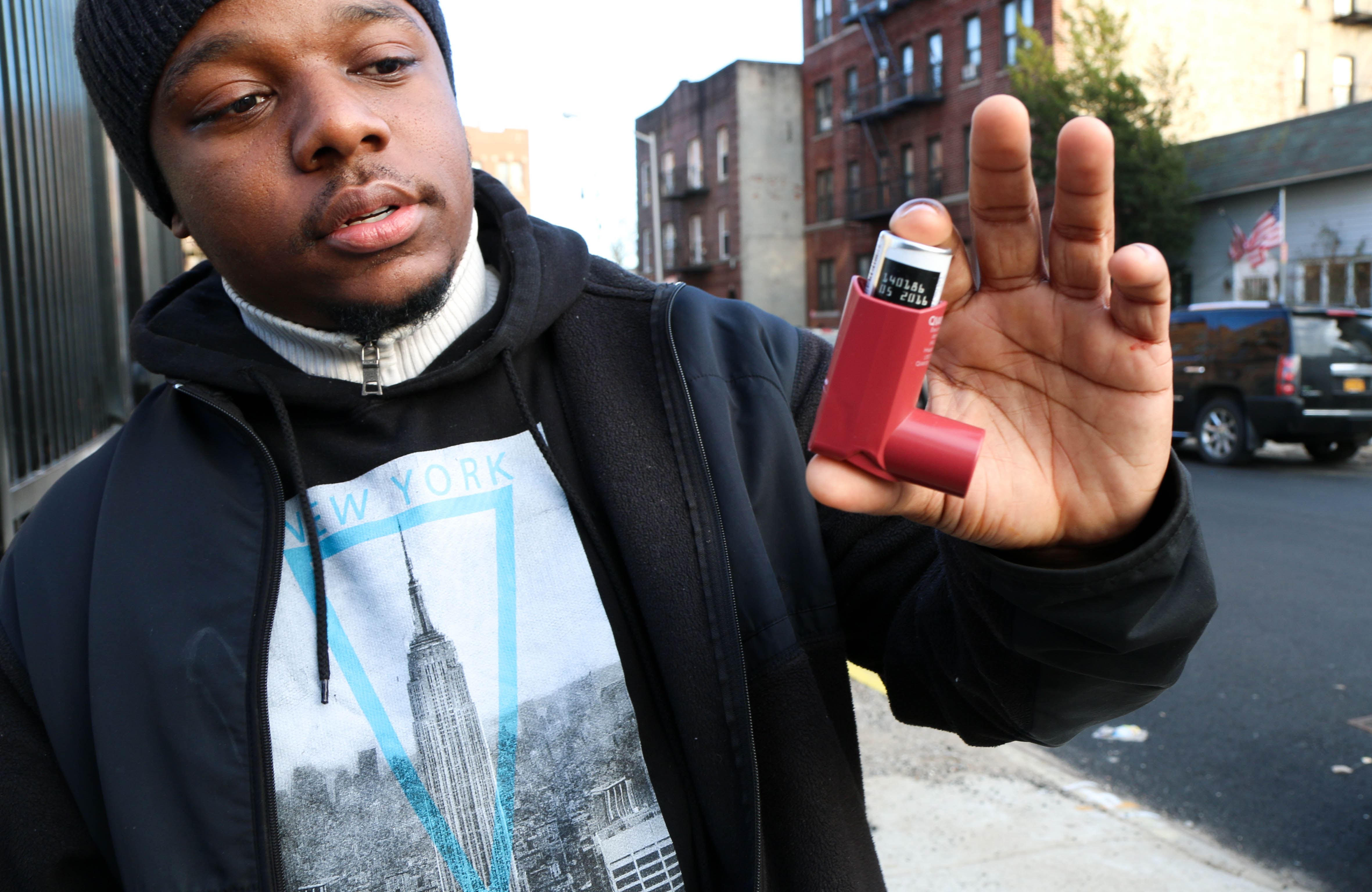
NEW YORK — Torren McIntyre steadies his feet on the corner of Erasmus Street and Nostrand Avenue in central Brooklyn and forces all the air out of his lungs. He puts his asthma inhaler to his lips, pushes down and inhales deeply. Holding his breath, now a mixture of air and the asthma medicine Symbicort, he counts to 10 and slowly exhales.
This is a routine that plays out for him every morning.
“I’ve had asthma forever,” McIntyre said. “When I was a little kid I always used to have asthma attacks.”
McIntyre, 23, recently aged out of foster care and says that without access to his medication he’d be seriously ill. Luckily for him, the state pays for it.
Young adults in every state who have aged out of the foster care system, like McIntyre, are now eligible for Medicaid under a new provision of the Affordable Care Act. Analysts believe that anywhere from 5,000 to 10,000 young people who have aged out of foster care in New York state are eligible but have yet to be connected to coverage.
Without this new health care provision, McIntyre’s two inhalers, nebulizer and ADHD medication would cost him more than $500 a month.
This little-known clause of the Affordable Care Act went into effect this January across the country. Young adults will now be insured until their 26th birthday — just like their peers who are permitted to stay on their parents’ health insurance until the same age.
On average, 1,300 youths age out of New York’s foster care system each year. Those who left after January 2014 are automatically enrolled in Medicaid.
However, those who left before this date need to sign up on their own — either through the Department of Social Services or through the state-run Internet marketplace. McIntyre, for instance, enrolled with the help of his social worker, Lakeya Harris.
Harris, who met McIntyre more than a year after he’d aged out of foster care in March 2014, accompanied him to an emergency room in May (neither wanted to disclose why). Hospital administrators told McIntyre he didn’t have health insurance — something that surprised both him and Harris, who’d been consumed with finding him housing first.
Because McIntyre had been using inhalers from a stock his mother had kept for his younger brother, who also suffers from asthma, he had not noticed he was no longer insured.
Harris said misinformation plagues the young people she works with.
Former foster care youth “are under the impression that Medicaid is ongoing,” Harris said. “They are not aware that when they age out of care … [coverage] expires and you have to reapply. They think it just continues.”
Tracking down these former foster youth and getting them the necessary information turns out to be quite a challenge.
Dr. Sylvia Rowlands, a senior vice president at The New York Foundling, should know. Her organization has been trying to contact former foster care youths since the program started. She says the main obstacle to enrolling this population is their reluctance to deal with state agencies they feel have betrayed them.
“They tend to get out of the system having some real trauma — and a good part of that is the trauma that’s related to being in foster care in the first place. So they don’t answer the phones when we call,” Rowlands said. “And if you do get them to answer the phone and say let’s meet at X day at X time, they may or may not show up to that.”
Numerous reports suggest that former foster youth need health care more than the general population. According to two studies published in the journal Pediatrics, 60 percent of young people in foster care suffer from chronic health conditions like asthma or anemia.
Kari Siddiqui, a policy analyst for the Schuyler Center for Analysis and Advocacy, said that young people with chronic conditions who age out and don’t know they’re eligible for coverage put a strain on the country’s hospitals and clinics.
“These youth who could have access to care but don’t know that they do are now going in uninsured and seeking services that are not being paid for,” she said. “A lot of them are going to ERs and free clinics or just sort of ignoring problems. It places a huge burden on the system.”
This makes getting the word out all the more critical.
The city’s Administration for Children’s Services (ACS) has distributed information among directors of foster care agencies, and the state’s Office of Child and Family Services (OCFS) is partnering with several nonprofit agencies to get the word out.
But outreach poses its own unique set of problems. For instance, quantifying the number of eligible foster youths is a task that has eluded state agencies.
The Schuyler Center estimates that New York City has 5,000 former foster care youth eligible for Medicaid who have not yet signed up, while statewide this number might be closer to 10,000. But Schuyler analyst Siddiqui stresses that this is only a rough estimate. She could not explain the lack of more reliable data.
“We’re also very curious to get those numbers,” she said. “Seems like it should be easier than it is.”
Siddiqui’s not the only one confused.
ACS said the city’s Human Resources Administration (HRA) tracks the number of former foster care adults who have enrolled. A spokesperson at HRA said that actually ACS is responsible for these numbers.
In the course of reporting this story, no state agency was able to provide a reliable figure.
“Our program people have let me know that we don’t track this sort of information,” said a spokesperson for ACS. “It appears that HRA does not either.”
Back in central Brooklyn, McIntyre takes two puffs of his inhaler each day and carries a rescue inhaler wherever he goes — just in case. When asked what he would do if he had to pay out of pocket for his inhaler, McIntyre paused. “I don’t really know,” he said.
He remembers the last time an asthma attack landed him in the hospital. He’d gone on a trip with his group home to New Hampshire a few months before he aged out. The air was too thin, and McIntyre said he couldn’t breathe when he got off the bus.
“I was in the hospital for three days,” he said.
Former foster care youth like McIntyre, who have found social workers or maintained good relationships with the state, are easy to connect with these benefits. Thousands others have few accessible sources of information.

































